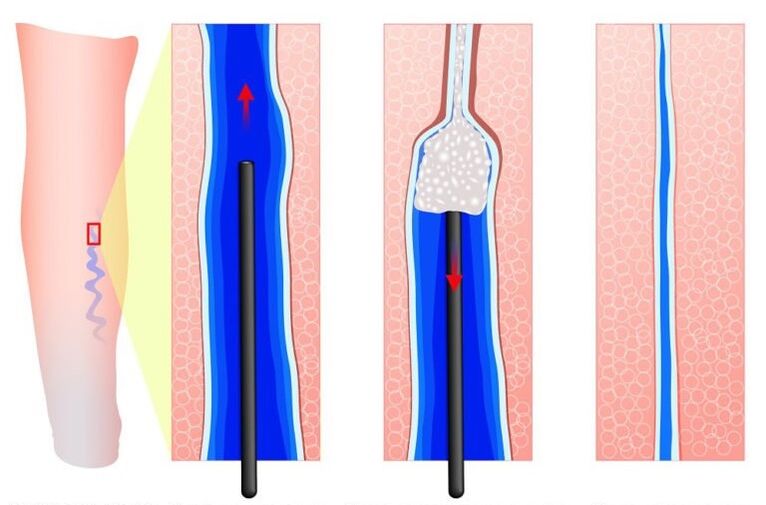Varicose veins (varicose veins) are a disease accompanied by an increase in length, the formation of pathological serpentine tortuosity of the veins, irreversible saccular enlargements of its lumen, and valve insufficiency. The organs of the lower pelvis are involved in the varicose process. The disease development mechanisms are different. Doctors include the perineal region, external and internal genitalia as atypical locations.
General information about pathology
The process of blood flow in the veins occurs in such a way that, under physiological conditions, the prerequisites for the development of stagnation and blood flow are created.
Vulvar varices (VV) - vasodilation of the external genital organs. The disease manifests itself in women who suffer from varicose veins in the pelvis and legs, as well as in pregnant women. In 30% of cases, pelvic varicose veins involve the perineum and vulva.
The start of treatment for the disease is delayed due to its location in an intimate place. Women are shy. In some cases, patients experience no pain or discomfort. But lip varices during pregnancy and not just during childbirth, present complications: obstruction of the veins by thrombus (thromboembolism), sexual sensitivity disorders, perineal pain, psycho-emotional problems and family conflicts.
The mechanisms for the occurrence of congestion in the pelvis vessels are not fully disclosed. The cause of the primary form of the disease is called malfunction of the valves in the gonadal (ovarian) veins. This causes a backflow of blood and increases the pressure on the venous nodules in the lower pelvis. Valve insufficiency can be acquired or congenital. It gets worse with age or pregnancy.
The secondary form of VVV of Organs pelvic organs is associated with gynecological pathologies: endometriosis, pelvic organ tumors.
Diagnosis of the disease is difficult due to the fact that there are no specific symptoms of its course. It is based on the results of the ultrasound (ultrasound).
To distinguish between the primary and secondary forms of pathology, the Valsalva test is used during the ultrasound examination. As a secondary cause of pelvic varices, it is negative.
Lip varices with VBT
To make a diagnosis of varicose lip veins, a medical examination is required. The symptoms of the disease are as follows:
- varicose veins on the genitals;
- pain in the external genital area;
- a heaviness and burning sensation in the perineum;
- swelling of the perineum later in the day.
Chronic pelvic pain occurs less frequently (in 30% of cases).
Once the diagnosis has been established, a study is carried out to identify the degree of complexity of the pathological process and prescribe the appropriate treatment. Several events are being held:
- examination of the veins of the perineum and legs by ultrasound angioscan - USAS;
- ultrasonography of the pelvic vessels, including the vaginal, uterine, parametric, ovarian, iliac, inferior vena cava and renal veins;
- according to the indications, multi-spiral computed tomography (MFCT), selective ovaricography, and pelvic phlebography (SOFT) are performed.
Doctors call a characteristic property of varicose veins in the lips with VBT that the disease is in constant progression and is combined with transformation of the intrapelvic veins.
Treatment of varicose veins of the vulva with varicose veins of the lower pelvis
IV treatment is prescribed based on symptoms and diagnostic results.
In complex drug therapy for the treatment of systemic chronic venous pathology, non-steroidal anti-inflammatory drugs and phlebotropic drugs are prescribed.
Prescribe pharmacotherapy with antiplatelet agents, intrapelvic blockade with antihypoxia, physiotherapy with ultrasound, therapeutic exercises. Antioxidants and enterobiotics are added to the therapy.
According to indications, the treatment of phlebosclerosis - sclerotherapy is carried out. The vessel is "sealed" with drugs and a laser. It stops working. The procedure does not use special methods of anesthesia. It is performed on an outpatient basis and produces a cosmetic effect.

With an abundance of pelvic veins, expansion and reflux of blood through the gonadal (ovarian) veins, a surgical operation to remove the veins is indicated. In the case of increased varices of the labia minora, it is removed.
Vulval varices during pregnancy
Pregnancy is the first most common risk factor that leads to the onset of VVV. A significant and sustained increase in progesterone concentration in the early stages of pregnancy reduces venous tone and worsens impaired blood flow. In addition, VBT involving the perineum and vulva is associated with compression of the large veins of the retroperitoneal region (iliac veins and inferior vena cava) by the pregnant uterus.

Doctors recommend compression garments during pregnancy.
Often, varicose veins of the vulva occur bilaterally. Signs of illness:
- a pronounced increase in vulval veins over a period of 18-24 weeks during the first pregnancy, starting at 12 weeks with a repeat pregnancy;
- groin discomfort;
- pulling, aching, dull pain in the pelvic region;
- pain during intercourse;
- itching of the vulva;
- swelling of the genitals and perineum.
Signs of evolution of the pathology with the course of pregnancy. In addition to increasing the size of varicose veins, their compaction is determined until the third trimester. A characteristic symptom of IV is its combination with inguinal varices during pregnancy or varicose veins in the legs.
The instrumental examination for varicose veins in pregnant women is limited to ultrasound, as well as ultrasound of the legs, as painful changes in the venous bed involute in the postpartum period.
In most cases (about 80%), from the first days of delivery, varicose vein symptoms during pregnancy begin to diminish and are minimized 2 to 8 months after the baby is born. There is no complete return of vessel diameter to its original values.
In 4-8% of women, the IV does not disappear after delivery and the disease progresses.
An interesting feature is the relationship between the end of the breastfeeding period or the reduction in the volume of breastfeeding with the rate of disappearance of varicose veins in the woman's groin. A shortened lactation period is accompanied by a decrease and disappearance of the dilated veins and vice versa. This proves that varicose veins in the perineum during pregnancy are associated with a change in hormone levels.
Treatment of Perineal Varicose During Pregnancy
The mainstay of therapy for varicose veins during pregnancy is phlebotropic treatment. In the main part of fertile women, IV starts in the II and III trimesters. During this period, diosmin preparations can be used. The severity of the symptoms of the pathology is reduced by the fraction of purified micronized flavonoids. The itching is relieved by zinc paste and histamine H1 receptor blockers.
Prophylactic low molecular weight heparin prevents venous thrombosis and pulmonary embolism (blockage of blood vessels).
As an option for compression treatment, it is recommended to wear tight-fitting elastic underwear with latex or gauze pillows. Relieves lip swelling and heaviness. The special compression shirt for women with vulvar varices helps a lot.
If a complication develops, such as local thrombophlebitis, surgical treatment is necessary.
When a cluster of varicose veins is found in Organs genitals, the question arises about the method of delivery. Natural childbirth is allowed with varicose veins from the vulva. On the contrary, the risks of surgery during a cesarean are greater than the onset of bleeding from painful vessels during childbirth. This rarely happens. But with varicose veins in the vagina, a caesarean is usually performed.
Prevention of lip varicose veins
The main factor in the formation of varicose veins in the groin is the delivery of the fetus. It is difficult to name any preventive method, taking into account the fact that during pregnancy there are a number of restrictions to many therapeutic measures. Some tips to follow:
- excludes physical and static stress;
- follow a diet;
- performing therapeutic exercises, in which the movements accelerate the flow of blood from the legs and lower pelvic organs;
- in case of interruption in the functioning of the veins, the presence of varicose veins before pregnancy, it is necessary to take phlebotropic drugs, wear compression underwear.
An effective method of prevention is considered an operation on the ovarian veins, surgery for other pathologies associated with varicose veins. This reduces the phenomenon of pelvic venous congestion, reduces the risk of varicose veins in the lips.
Vulvar varicose veins are a common condition in women with varicose veins in the pelvis, legs, or during pregnancy.
In order to improve the quality of treatment of patients with chronic venous diseases, it is important to detect the disease and differentiate between the methods of diagnosis and treatment of this condition.




































